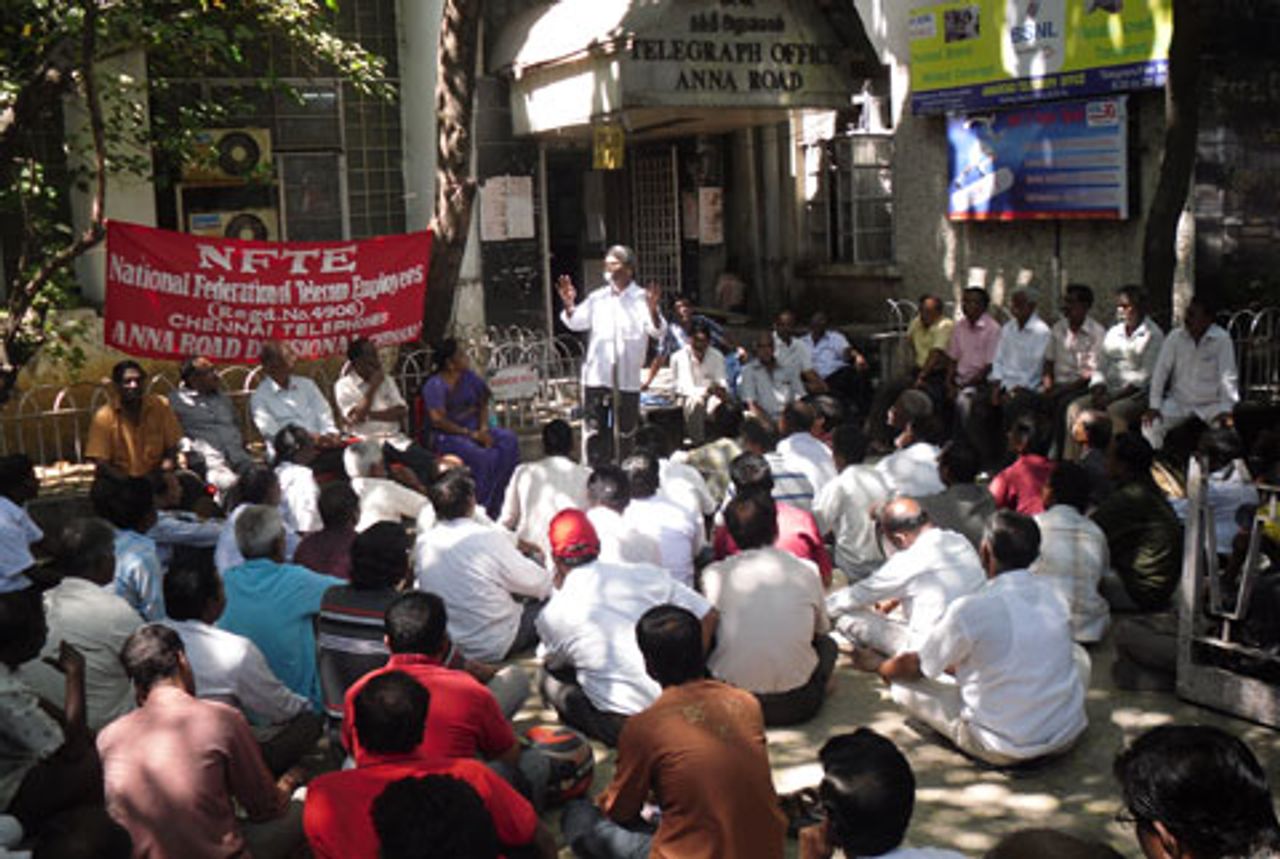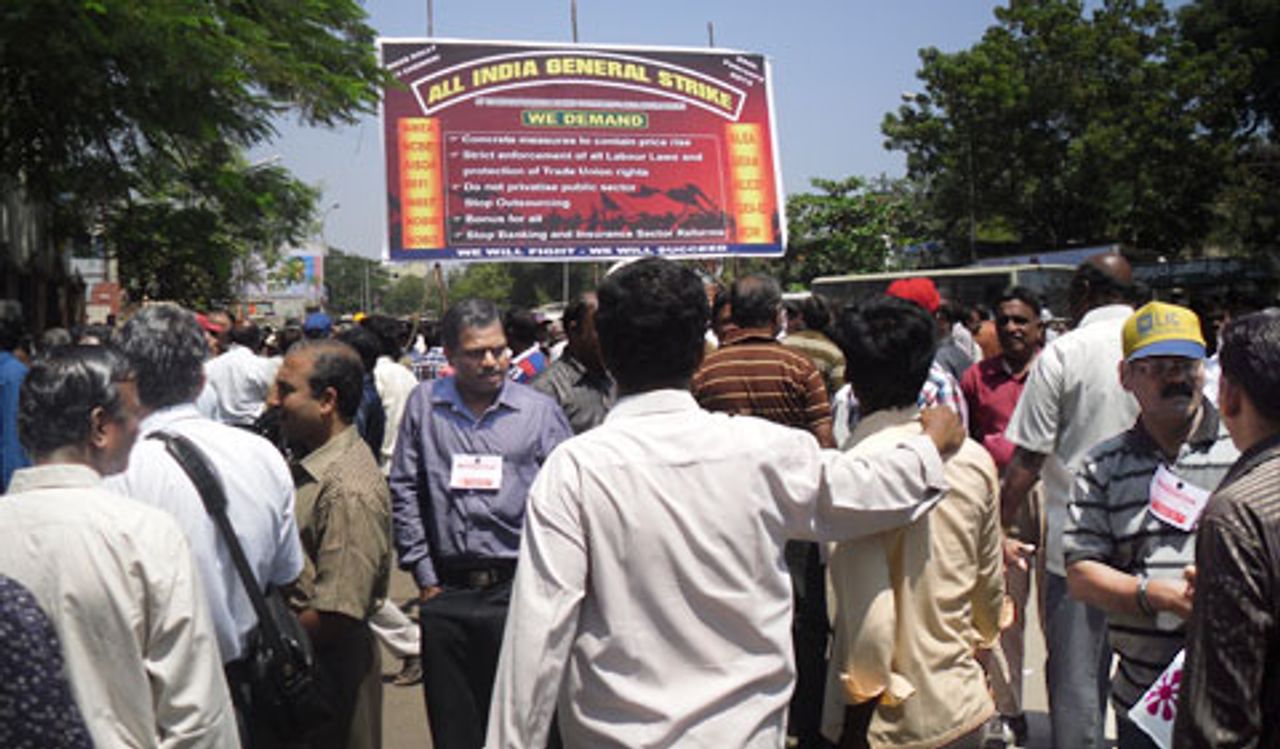As many as a hundred million workers participated in a one-day, India-wide general strike Tuesday to protest against the socio-economic policies of the Congress Party-led United Progressive Alliance government and support a 10-point charter of demands.
The demands included: action to contain rising prices; a halt to privatization; an end to government complicity in employers’ systematic violation of labour regulations; equal pay and rights for the large number of contract workers employed in industry and the public sector; and the provision of social benefits to the vast majority of India’s workers who toil under sweatshop-type conditions in the so-called unorganized sector.
 An official of the National Union of Telecom Workers addresses a rally outside a telegraph office in Chennai
An official of the National Union of Telecom Workers addresses a rally outside a telegraph office in ChennaiThe strike was called by the eleven government-recognized national trade union centrals, including those affiliated with the two Stalinist parliamentary parties—the Communist Party of India (CPI) and the Communist Party of India (Marxist) [CPM]—and the respective labor wings of the Congress Party and the Official Opposition, the Hindu supremacist Bharatiya Janata Party or BJP.
The strike’s impact varied widely by state and industry.
It paralyzed the activities of public sector banks and insurance companies, postal services, much of the public transport system, and government-owned ports across most of India. Much of the coal industry was shut down and there were walkouts at many manufacturing plants, including in the Gurgaon-Manesar industrial belt, the scene last year of a series of militant strikes and plant occupations by Maruti-Suzuki car assembly workers.
The national rail network and air traffic, by contrast, were scarcely affected.
Normal life in the southwestern state of Kerala ground to a halt, with buses off the roads and shops closed, as workers ignored an order from the Congress Party-led United Democratic Front government to dock the pay of all state employees who joined the strike.
The strike had a major impact in Mumbai, India’s financial capital, and more broadly in the western Indian state of Maharashtra in which it lies. The walkout of employees at state banks and at the Reserve Bank of India, the country’s central bank, seriously disrupted the operations of non-unionized private banks.
The AIADMK government of the southern Indian state of Tamil Nadu took provocative measures to break the strike, particularly in the transport sector. Drivers and conductors on state-owned buses were offered double-pay if they worked Tuesday. Nevertheless, the strike had a significant impact, as many central and state government employees, including in banking and telecommunications joined the strike. In the textile-manufacturing centers of Tripur and Coimbatore, tens of thousands of workers walked off the job.
In West Bengal, the right-wing Trinamool Congress government mounted a determined effort to break the strike, mobilizing the police and goon squads to harass and intimidate strike supporters. In the run-up to the strike, the government issued a circular announcing that state government employees who failed to show up for work on Tuesday could be deemed to have committed a “break in service,” a reprisal that would mean the loss of all their accumulated pension benefits.
In the face of this threat, most state employees did report to work and in Kolkata, the state capital and India’s third most populous city, state-owned bus and subways functioned normally. But otherwise, the strike was massively supported, with workers in coal, power generation, construction and many other industries walking off the job. About 90 percent of tea garden workers struck. Most central government offices, mainly banks, insurance, postal and telephone, were closed.
And while the state-owned transport system functioned, most private busses, and three-wheeler and other taxis operators joined the strike—despite a threat by State Transport Minister Madan Mitra that private bus operators who failed to run their buses on Tuesday would not be allowed to operate for the ensuing week.
As a part of its anti-strike measures, the government deployed an additional 15,000 police in Kolkata alone. More than 2,000 strike supporters were arrested across the state.
Chief Minister Mamata Banerjee has ordered all government departments to submit the names of those who were absent from work Tuesday. According to press reports, she has yet to decide whether to make good on the threat to strip strike supporters of their pension benefits. Such a draconian and vindictive reprisal would undoubtedly trigger widespread demands from rank-and-file workers for immediate strike action.
In Bangalore, an IT hub in BJP-ruled Karnataka, workers in most government offices and banks, and three-wheeler taxi drivers joined the strike. Shops and schools were closed. While the IT-industry functioned normally, the government’s deployment of additional buses failed to prevent the strike from having a broad impact. In Karnataka, as in many other parts of India, an important element in the strike’s impact was the sizeable participation of workers from the “unorganized sector”—including three-wheeler drivers, construction workers, warehouse laborers, and anganwadi (community health) workers.
Tuesday’s protest strike and a recent wave of bitter strikes in India’s new globally integrated manufacturing sector—including at plants owned by Foxconn, BYD Electronics, Hyundai, and makers of parts for Ford, GM, and other transnational auto makers—attest to the growing anger and militancy within the working class.
India’s elite and the Obama administration gush incessantly about India’s “rise”, but the expansion of Indian capitalism over the past two decades has been accomplished through the ruthless exploitation of the working class and in the midst of an agrarian crisis directly attributable to big business’ pro-market agenda.
Moreover, the Indian elite, like its counterparts around the world, has responded to the global economic crisis, by pressing for an intensification of the assault on working people. They are demanding that the Congress Party-led UPA slash social spending, eliminate price subsidies and gut restrictions on layoffs and plant closures. The response of much of the corporate media to the protest strike was vituperative. “It is time the UPA government overcame its ambivalence and … pushed ahead with long-delayed labour reforms,” thundered the New Indian Express.
But whilst Tuesday’s strike was proof of mounting worker militancy, the unions who called it did not do so to initiate a working class challenge to the UPA government and the bourgeoisie’s program of making India a haven for cheap-labor production for world capitalism, but rather to contain and politically suppress the working class.
The leadership of the strike was very much in the hands of the CPI and CPM through their labor federations, respectively the All India Trades Union Congress (AITUC) and the Centre of Indian Trade Unions (CITU). Over the past two decades the Stalinists have called 14 one-day general strikes as political cover for the leading role they have played in imposing Indian big business’ agenda. The Stalinists have repeatedly propped up governments at the Center, including for four years the current UPA government, and in those states where they have held office they have openly pursued pro-investor policies.
The Stalinists have hailed the decision of the Congress and BJP unions to join Tuesday’s strike as “historic.” On Tuesday, AITUC General Secretary Gurudas Dasgupta praised G. Sanjiva Reddy, the President of the Congress-affiliated INTUC and a Congress MP, as a “most consistent fighter in our joint struggle.”
The Stalinists’ embrace of the Congress and BJP unions is clearly a stepping stone to a further round of reactionary political alliances between the Stalinist-led Left Front and the open parties of Indian big business.
 Pro-strike rally Tuesday in Chennai, the capital of the southern Indian state of Tamil Nadu
Pro-strike rally Tuesday in Chennai, the capital of the southern Indian state of Tamil NaduWorld Socialist Web Site correspondents spoke Tuesday to several striking workers in Chennai.
Sekar, a postal worker, said, “For many years there hasn’t been new recruitment in the post offices. As a result the existing work force bears an enormous work load. There are still tens of thousands of contract employees who have not been made regular after so many years of work.”
Sridhar a telegraph worker, told the WSWS: “More than half of the workers took part in the strike. But nearly 40 percent did not, because they are concerned about losing about Rs.1,000 [US $20] according to the ‘No work No Pay’ rules of the government.” The WSWS correspondents pointed out that there are other reasons sections of workers might have chosen not to participate in the strike, including the fact that all the major trade unions that called it are affiliated to political parties that have been instrumental in the implementation of pro-market reforms. Expressing his agreement with this comment, Sridhar said, “All these political parties implement anti-labor policies which they claim to oppose while in opposition. This is deception.”
These authors also recommend:
Indian workers must adopt socialist strategy to oppose UPA-led big business offensive
[28 February 2012]
